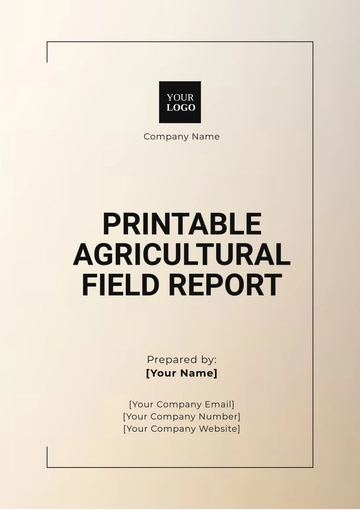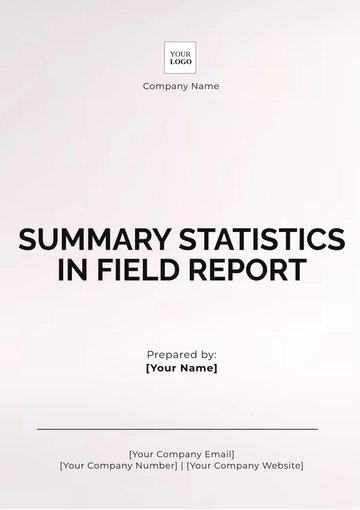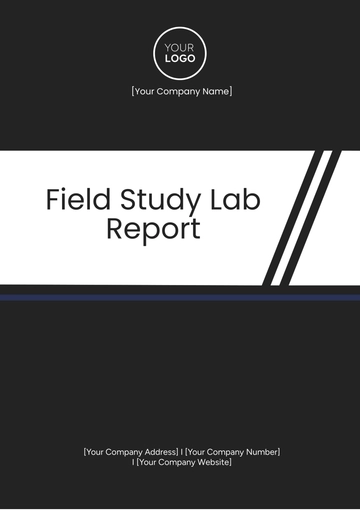Free Printable Agricultural Field Report

Prepared by: [Your Name]
Date: March 15, 2050
I. Field and Crop Information
A. Field Location and Size
The field is located in the northern plains, covering approximately 50 acres. It is situated near riverbanks, creating a beneficial microclimate that supports the growth of a wide variety of crops. The proximity to water reduces drought stress and provides a slight buffer against extreme temperature fluctuations.
B. Crop Details
Two primary crops were planted for this season: corn and soybean. Below are the specific details for each crop:
Crop Type | Variety | Planting Date |
|---|---|---|
Corn | Dent Corn Hybrid | March 15, 2050 |
Soybean | Glycine Max | April 1, 2050 |
These crops were selected based on market demand and their adaptability to the field’s microclimate and soil conditions.
II. Weather Conditions
A. Temperature
The temperature during the growing season ranged between 60°F and 85°F, with cooler nights promoting crop respiration and daytime temperatures conducive to growth. Peak temperatures were observed in mid-July, which slightly stressed the crops, but overall, the temperature stayed within optimal growing ranges.
B. Rainfall
Total seasonal rainfall was recorded at 18 inches. While slightly below the region’s average of 20 inches, the shortfall was compensated by bi-weekly irrigation. Rain events were well-distributed, preventing any significant drought stress, though supplemental irrigation played a vital role during July and August.
III. Soil Analysis
A. Soil Composition
The field soil was classified as sandy loam, which offers good drainage while retaining enough moisture to support crop growth. The organic matter level was tested at 3.5%, indicating sufficient fertility to sustain crops with minimal external input. Organic amendments, such as compost, were added to further improve soil structure.
B. pH Levels
Soil pH was recorded at 6.5, which is ideal for both corn and soybean. Regular soil pH monitoring is recommended to maintain this balance, especially since irrigation and fertilization practices can alter soil pH over time.
IV. Pest and Disease Report
A. Pest Incidence
There was a minor infestation of corn rootworm during the early stages of growth, but it was managed effectively using biological control methods, specifically the introduction of predatory nematodes. This reduced the need for chemical pesticides, aligning with sustainable farming practices.
B. Disease Occurrence
No significant disease outbreaks were observed during the growing season. Occasional signs of leaf blight in corn were detected but were managed with increased monitoring and preventive measures, including improved ventilation between rows. Disease pressure remains low due to vigilant crop management and proper spacing techniques.
V. Farming Activities
A. Irrigation
Irrigation was conducted bi-weekly using a drip irrigation system, promoting water efficiency and reducing surface evaporation. The system delivered water directly to the root zones, ensuring that crops received adequate moisture without waterlogging the soil. Adjustments to irrigation timing were made based on weather conditions and soil moisture tests.
B. Fertilization
A balanced NPK (Nitrogen, Phosphorus, and Potassium) fertilizer was applied three times over the growing season—once during planting, mid-season, and right before flowering. Additional micronutrients such as calcium and magnesium were also supplemented based on soil tests, which showed a slight deficiency.
VI. Yield Data
A. Crop Performance
Crop | Yield (Bushels) | Expected Yield (Bushels) |
|---|---|---|
Corn | 8,500 | 9,000 |
Soybean | 3,200 | 3,500 |
The yield for both crops came slightly below expectations, largely due to the limited rainfall and minor pest pressure. However, quality remained high, and the majority of the harvested produce met market standards for premium pricing.
VII. Recommendations
Based on the findings of this report, the following recommendations are made to enhance productivity and minimize future risks:
Improve Irrigation Scheduling
Fine-tune irrigation scheduling to better retain soil moisture during dry periods, especially by integrating soil moisture sensors. Consider incorporating rainwater harvesting systems to supplement irrigation during dry spells.Regular Soil Health Monitoring
Conduct soil health checks more frequently to ensure nutrient levels, particularly nitrogen and potassium, remain within optimal ranges. Regularly testing for pH and adjusting soil amendments will ensure sustained crop health.Integrated Pest Management
Continue utilizing integrated pest management (IPM) strategies to prevent future infestations. Strengthen the use of biological control agents and introduce crop rotation methods to disrupt pest life cycles.Advanced Weather Monitoring
Implement the use of advanced weather prediction models and real-time monitoring systems. This will allow for better planning of irrigation, fertilization, and pest control activities, ensuring they align with weather patterns.Crop Diversification
Introduce additional crop varieties that are more resistant to pests and drought. Rotating crops will also help maintain soil health and reduce pest and disease pressure.
- 100% Customizable, free editor
- Access 1 Million+ Templates, photo’s & graphics
- Download or share as a template
- Click and replace photos, graphics, text, backgrounds
- Resize, crop, AI write & more
- Access advanced editor
Capture vital agricultural data with the Printable Agricultural Field Report Template from Template.net. This editable and customizable template is designed to record field observations, crop conditions, and farming activities. Whether you're monitoring plant health or soil quality, this template is editable in our AI Editor Tool for quick adjustments, offering easy-to-use options to meet your reporting needs.
You may also like
- Sales Report
- Daily Report
- Project Report
- Business Report
- Weekly Report
- Incident Report
- Annual Report
- Report Layout
- Report Design
- Progress Report
- Marketing Report
- Company Report
- Monthly Report
- Audit Report
- Status Report
- School Report
- Reports Hr
- Management Report
- Project Status Report
- Handover Report
- Health And Safety Report
- Restaurant Report
- Construction Report
- Research Report
- Evaluation Report
- Investigation Report
- Employee Report
- Advertising Report
- Weekly Status Report
- Project Management Report
- Finance Report
- Service Report
- Technical Report
- Meeting Report
- Quarterly Report
- Inspection Report
- Medical Report
- Test Report
- Summary Report
- Inventory Report
- Valuation Report
- Operations Report
- Payroll Report
- Training Report
- Job Report
- Case Report
- Performance Report
- Board Report
- Internal Audit Report
- Student Report
- Monthly Management Report
- Small Business Report
- Accident Report
- Call Center Report
- Activity Report
- IT and Software Report
- Internship Report
- Visit Report
- Product Report
- Book Report
- Property Report
- Recruitment Report
- University Report
- Event Report
- SEO Report
- Conference Report
- Narrative Report
- Nursing Home Report
- Preschool Report
- Call Report
- Customer Report
- Employee Incident Report
- Accomplishment Report
- Social Media Report
- Work From Home Report
- Security Report
- Damage Report
- Quality Report
- Internal Report
- Nurse Report
- Real Estate Report
- Hotel Report
- Equipment Report
- Credit Report
- Field Report
- Non Profit Report
- Maintenance Report
- News Report
- Survey Report
- Executive Report
- Law Firm Report
- Advertising Agency Report
- Interior Design Report
- Travel Agency Report
- Stock Report
- Salon Report
- Bug Report
- Workplace Report
- Action Report
- Investor Report
- Cleaning Services Report
- Consulting Report
- Freelancer Report
- Site Visit Report
- Trip Report
- Classroom Observation Report
- Vehicle Report
- Final Report
- Software Report



























